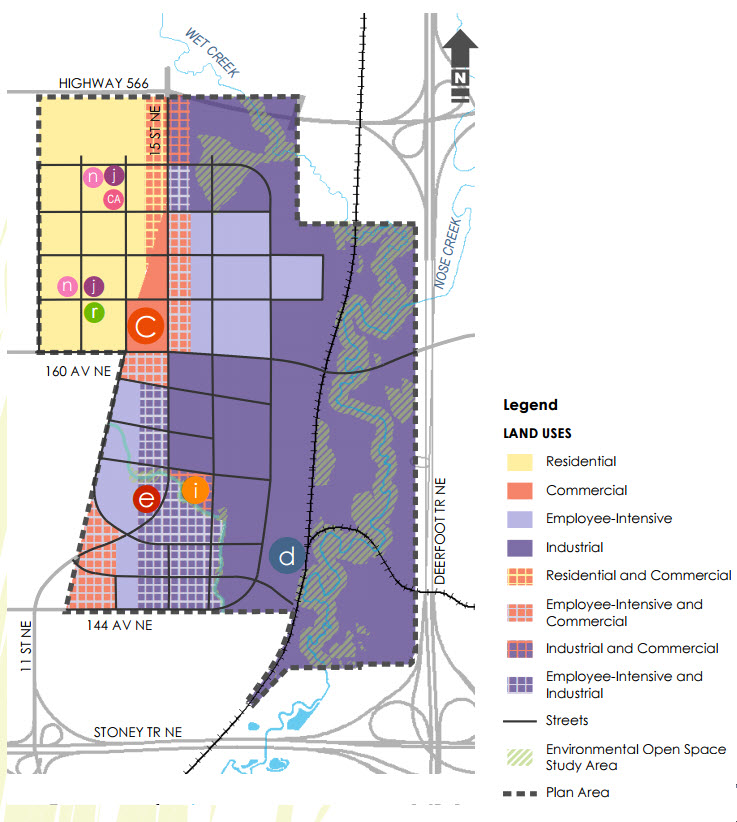
Dec. 08, 2016 | Joel Schlesinger
Healthy homes, healthier people
Pilot planning initiative puts public health front and centre of new community developmentA stretch of Nose Creek that straddles Calgary's northwest and northeast quadrants may now be only home to scenic, rolling grassy hills.
But soon enough, about 9,000 city residents could being calling it home sweet home, along with 21,000 jobs, as planning is underway to develop a community with residential, commercial and industrial opportunities.
Most notably, however, is this community, once built, will be one of city's healthiest places to live, work and play.
Consisting of nearly 680 hectares west of Deerfoot Trail and north of Stoney Trail, the parcel has been the focus of a City of Calgary pilot planning project that's aiming to incorporate public health concerns as the foundation of future development in the area.
Central to the Nose Creek Area Structure Plan — completed last year — is a relatively novel concept for residential community development: a health impact assessment (HIA).
Often used when developing major industrial or natural resource extraction projects, HIAs examine a broad range of health issues regarding a development.
 Joyce Tang with the City of Calgary said a health impact assessment will be used to plan for a new community bordering the northern city limits.
Joyce Tang with the City of Calgary said a health impact assessment will be used to plan for a new community bordering the northern city limits.More recently, they are front and centre of planning concerns for major North American cities such as Calgary.
"It's an incredibly important consideration," said Joyce Tang, project manager with Urban Strategy Group at the City of Calgary, which headed up the initiative that began in 2014.
"Just as planning has addressed infectious disease during industrialization, new city developments have the potential to address our health concerns today."
Tang said health concerns have always been a core pillar of urban planning. In fact, the discipline's origin comes from a need to address the health issues faced by cities as a result of industrialization, leading to standardization for building codes and commonplace infrastructure of today such as safe drinking water and sewage disposal.
Tang said health planning concerns in recent decades have evolved from being less focused on issues such as air pollution and fire prevention — though still important considerations — to promoting community designs that enhance better overall well-being.
In part, this is a reaction to the way communities have developed over the last 60 years, said Tang.
"In the middle of the 20th century, we had a boom of the auto industry, and suburbs of single-use communities – where people were trying to escape the dirty industrial city for a healthier living where there was access to more space," she said. "This resulted in people spending more time in cars driving to various activities."
Over time, population health studies have found a link between suburban living and the rise of chronic health conditions that are reaching epidemic levels in North American society where the automobile —unlike other parts of the world — is king.
Of course, the rise of suburbia isn't entirely to blame for increasing incidence of chronic illnesses such as obesity, type-2 diabetes, cardiovascular disease, and depression. Our eating habits, increased reliance on technology for social interaction and more sedentary lifestyles are culprits, too.
But studies show a relationship between typical suburban design and poorer health outcomes, said Dr. Gerry Predy, senior medical officer of health for Alberta Health Services.
"What the research has found is that neighbourhoods that are walkable, where there are not necessarily a lot of cul-de-sacs and there's instead a grid design for the roadways, promote better health outcomes," he said.
While new developments are unlikely to move back to grid designs commonplace in older neighbourhoods, developers are increasingly incorporating walking and bike paths to promote active lifestyles.
Moreover, the provincial government – though it doesn't mandate these characteristics for new developments — does work with municipalities and developers to make designs that promote healthy living fundamental to community plans.
"Certainly, we want to encourage healthy transportation networks where there's available public transit, sidewalks and trails to get people outside and active," said Predy.
Promoting health and wellness through community design has been a secondary concern until recently, at least outside the U.S., said Erica Westwood, project manager with Habitat Health Impact Consulting.
"In terms of planning in Calgary, it's a new concept," she said, whose company helped develop the HIA for Nose Creek.
In particular, making HIAs a foundational planning tool and integrating their recommendations into a community plan from the start is unprecedented in the city. While HIA principles have been used before to lesser degrees, they haven't been central to an area plan, said Tang. Nor has any previous initiative been as comprehensive.

"This HIA incorporated eight healthy planning principles we developed, and the policy plan will guide the future development for the future of Nose Creek to develop into a healthy community," she said.
These principles include active areas — such as parks and leisure centres — that encourage physical activity.
They also call for designs fostering interaction among community members with public spaces for community events while ensuring the focus of neighbourhoods is less about automobiles and more about connecting people.
This is, in part, a nod to how suburban developments have largely featured too many homes with attached garages. These designs can increase isolation and reduce neighbourly interaction: people go from their home into their garage to their car and drive to work, and then back again without ever setting foot on their street-front.
"There is some evidence that having some face-to-face interaction is good for mental health," said Predy. "Anything in community design that can encourage interaction with your neighbours would be something that could improve your health."
Another major spoke to the pilot plan is promoting access to healthy food with local groceries and even community gardens.
In part, the Nose Creek pilot is intended to avoid mistakes of the past that have led to the problems of today, such as food deserts where access to affordable groceries is limited.
"We know from social determinants of health that it's important for people to have good access to places selling healthy food, and that's a major issue in low-income neighbourhoods where there may be no supermarkets in close proximity," said Predy.
The HIA's role is to help weave these social determinants of health — which also include good access to educational and job opportunities, and integrated housing for a variety of economic backgrounds – into the fabric of a new community, added Westwood.
"You can then enhance the positives by using a health impact assessment while addressing the potential negatives, she said, adding the Calgary-based firm is poised to see residential development a rapidly growing part of its business. "It is something that is picking up everywhere."
Until the Nose Creek pilot, HIAs in Calgary had been very limited in scope. Still some principles are already being incorporated into planning and development, said Tang.
"In the South Hill Green line, the project lead used the same HIA health principles and modeled her approach after that of Nose Creek ASP (area structure plan) into her plan," she said.
More broadly, the City is increasingly focused on promoting active transport — walking, busing and biking — throughout Calgary.
"For example, we just worked with our colleagues in roads to improve the sidewalks in Chinatown, where the sidewalks were uneven and people were battling cars that were being parked up on the sidewalk," said Tang.
"So we are looking at providing seating areas for people to gather to reclaim the sidewalk with strategic placement of benches, trees and other elements."
Ultimately, it's about making communities better, she added.
"(We want to give) people good reasons to go outside by ensuring they have fair access to open space, or a mix of housing options in a community so people can age in the same neighbourhood," said Tang.
It's about creating, "neighbourhoods with a mix of housing types, uses and retail spaces that would provide access to healthy foods," and other opportunities important to overall health.
Tagged: Alberta Health Services | area structure plan | Calgary Real Estate | Calgary Real Estate News | City of Calgary | Commercial | Deerfoot Trail | Health | neighbourhoods | Nose Creek | Residential | Stoney Trail | suburban | Uncategorized | wellness | YYCRE




